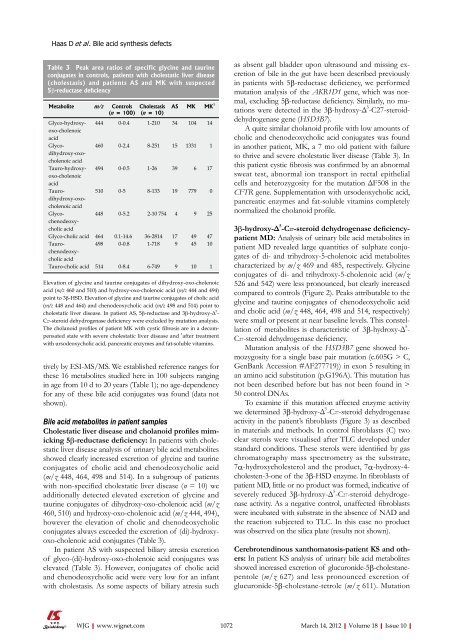10 - World Journal of Gastroenterology
10 - World Journal of Gastroenterology
10 - World Journal of Gastroenterology
Create successful ePaper yourself
Turn your PDF publications into a flip-book with our unique Google optimized e-Paper software.
Haas D et al . Bile acid synthesis defects<br />
Table 3 Peak area ratios <strong>of</strong> specific glycine and taurine<br />
conjugates in controls, patients with cholestatic liver disease<br />
(cholestasis) and patients AS and MK with suspected<br />
5β-reductase deficiency<br />
Metabolite m/z Controls<br />
(n = <strong>10</strong>0)<br />
tively by ESI-MS/MS. We established reference ranges for<br />
these 16 metabolites studied here in <strong>10</strong>0 subjects ranging<br />
in age from <strong>10</strong> d to 20 years (Table 1); no age-dependency<br />
for any <strong>of</strong> these bile acid conjugates was found (data not<br />
shown).<br />
Bile acid metabolites in patient samples<br />
Cholestatic liver disease and cholanoid pr<strong>of</strong>iles mimicking<br />
5β-reductase deficiency: In patients with cholestatic<br />
liver disease analysis <strong>of</strong> urinary bile acid metabolites<br />
showed clearly increased excretion <strong>of</strong> glycine and taurine<br />
conjugates <strong>of</strong> cholic acid and chenodeoxycholic acid<br />
(m/z 448, 464, 498 and 514). In a subgroup <strong>of</strong> patients<br />
with non-specified cholestatic liver disease (n = <strong>10</strong>) we<br />
additionally detected elevated excretion <strong>of</strong> glycine and<br />
taurine conjugates <strong>of</strong> dihydroxy-oxo-cholenoic acid (m/z<br />
460, 5<strong>10</strong>) and hydroxy-oxo-cholenoic acid (m/z 444, 494),<br />
however the elevation <strong>of</strong> cholic and chenodeoxycholic<br />
conjugates always exceeded the excretion <strong>of</strong> (di)-hydroxyoxo-cholenoic<br />
acid conjugates (Table 3).<br />
In patient AS with suspected biliary atresia excretion<br />
<strong>of</strong> glyco-(di)-hydroxy-oxo-cholenoic acid conjugates was<br />
elevated (Table 3). However, conjugates <strong>of</strong> cholic acid<br />
and chenodeoxycholic acid were very low for an infant<br />
with cholestasis. As some aspects <strong>of</strong> biliary atresia such<br />
WJG|www.wjgnet.com<br />
Cholestasis<br />
(n = <strong>10</strong>)<br />
AS MK MK 1<br />
Glyco-hydroxyoxo-cholenoic<br />
acid<br />
444 0-0.4 1-2<strong>10</strong> 34 <strong>10</strong>4 14<br />
Glycodihydroxy-oxocholenoic<br />
acid<br />
460 0-2.4 8-251 15 1331 1<br />
Tauro-hydroxyoxo-cholenoic<br />
acid<br />
494 0-0.5 1-26 39 6 17<br />
Taurodihydroxy-oxocholenoic<br />
acid<br />
5<strong>10</strong> 0-5 8-133 19 779 0<br />
Glycochenodeoxycholic<br />
acid<br />
448 0-5.2 2-<strong>10</strong> 754 4 9 25<br />
Glyco-cholic acid 464 0.1-14.6 36-2814 17 49 47<br />
Taurochenodeoxycholic<br />
acid<br />
498 0-0.8 1-718 9 45 <strong>10</strong><br />
Tauro-cholic acid 514 0-8.4 6-749 9 <strong>10</strong> 1<br />
Elevation <strong>of</strong> glycine and taurine conjugates <strong>of</strong> dihydroxy-oxo-cholenoic<br />
acid (m/z 460 and 5<strong>10</strong>) and hydroxy-oxo-cholenoic acid (m/z 444 and 494)<br />
point to 3β-HSD. Elevation <strong>of</strong> glycine and taurine conjugates <strong>of</strong> cholic acid<br />
(m/z 448 and 464) and chenodeoxycholic acid (m/z 498 and 514) point to<br />
cholestatic liver disease. In patient AS, 5β-reductase and 3β-hydroxy-Δ 5 -<br />
C27-steroid dehydrogenase deficiency were excluded by mutation analysis.<br />
The cholanoid pr<strong>of</strong>iles <strong>of</strong> patient MK with cystic fibrosis are in a decompensated<br />
state with severe cholestatic liver disease and 1 after treatment<br />
with ursodeoxycholic acid, pancreatic enzymes and fat-soluble vitamins.<br />
as absent gall bladder upon ultrasound and missing excretion<br />
<strong>of</strong> bile in the gut have been described previously<br />
in patients with 5β-reductase deficiency, we performed<br />
mutation analysis <strong>of</strong> the AKR1D1 gene, which was normal,<br />
excluding 5β-reductase deficiency. Similarly, no mutations<br />
were detected in the 3β-hydroxy-Δ 5 -C27-steroiddehydrogenase<br />
gene (HSD3B7).<br />
A quite similar cholanoid pr<strong>of</strong>ile with low amounts <strong>of</strong><br />
cholic and chenodeoxycholic acid conjugates was found<br />
in another patient, MK, a 7 mo old patient with failure<br />
to thrive and severe cholestatic liver disease (Table 3). In<br />
this patient cystic fibrosis was confirmed by an abnormal<br />
sweat test, abnormal ion transport in rectal epithelial<br />
cells and heterozygosity for the mutation ΔF508 in the<br />
CFTR gene. Supplementation with ursodeoxycholic acid,<br />
pancreatic enzymes and fat-soluble vitamins completely<br />
normalized the cholanoid pr<strong>of</strong>ile.<br />
3β-hydroxy-Δ 5 -C27-steroid dehydrogenase deficiencypatient<br />
MD: Analysis <strong>of</strong> urinary bile acid metabolites in<br />
patient MD revealed large quantities <strong>of</strong> sulphate conjugates<br />
<strong>of</strong> di- and trihydroxy-5-cholenoic acid metabolites<br />
characterized by m/z 469 and 485, respectively. Glycine<br />
conjugates <strong>of</strong> di- and trihydroxy-5-cholenoic acid (m/z<br />
526 and 542) were less pronounced, but clearly increased<br />
compared to controls (Figure 2). Peaks attributable to the<br />
glycine and taurine conjugates <strong>of</strong> chenodeoxycholic acid<br />
and cholic acid (m/z 448, 464, 498 and 514, respectively)<br />
were small or present at near baseline levels. This constellation<br />
<strong>of</strong> metabolites is characteristic <strong>of</strong> 3β-hydroxy-Δ 5 -<br />
C27-steroid dehydrogenase deficiency.<br />
Mutation analysis <strong>of</strong> the HSD3B7 gene showed homozygosity<br />
for a single base pair mutation (c.605G > C,<br />
GenBank Accession #AF277719)) in exon 5 resulting in<br />
an amino acid substitution (p.G196A). This mutation has<br />
not been described before but has not been found in ><br />
50 control DNAs.<br />
To examine if this mutation affected enzyme activity<br />
we determined 3β-hydroxy-Δ 5 -C27-steroid dehydrogenase<br />
activity in the patient’s fibroblasts (Figure 3) as described<br />
in materials and methods. In control fibroblasts (C) two<br />
clear sterols were visualised after TLC developed under<br />
standard conditions. These sterols were identified by gas<br />
chromatography mass spectrometry as the substrate,<br />
7α-hydroxycholesterol and the product, 7α-hydroxy-4cholesten-3-one<br />
<strong>of</strong> the 3β-HSD enzyme. In fibroblasts <strong>of</strong><br />
patient MD, little or no product was formed, indicative <strong>of</strong><br />
severely reduced 3β-hydroxy-Δ 5 -C27-steroid dehydrogenase<br />
activity. As a negative control, unaffected fibroblasts<br />
were incubated with substrate in the absence <strong>of</strong> NAD and<br />
the reaction subjected to TLC. In this case no product<br />
was observed on the silica plate (results not shown).<br />
Cerebrotendinous xanthomatosis-patient KS and others:<br />
In patient KS analysis <strong>of</strong> urinary bile acid metabolites<br />
showed increased excretion <strong>of</strong> glucuronide-5β-cholestanepentole<br />
(m/z 627) and less pronounced excretion <strong>of</strong><br />
glucuronide-5β-cholestane-tetrole (m/z 611). Mutation<br />
<strong>10</strong>72 March 14, 2012|Volume 18|Issue <strong>10</strong>|

















